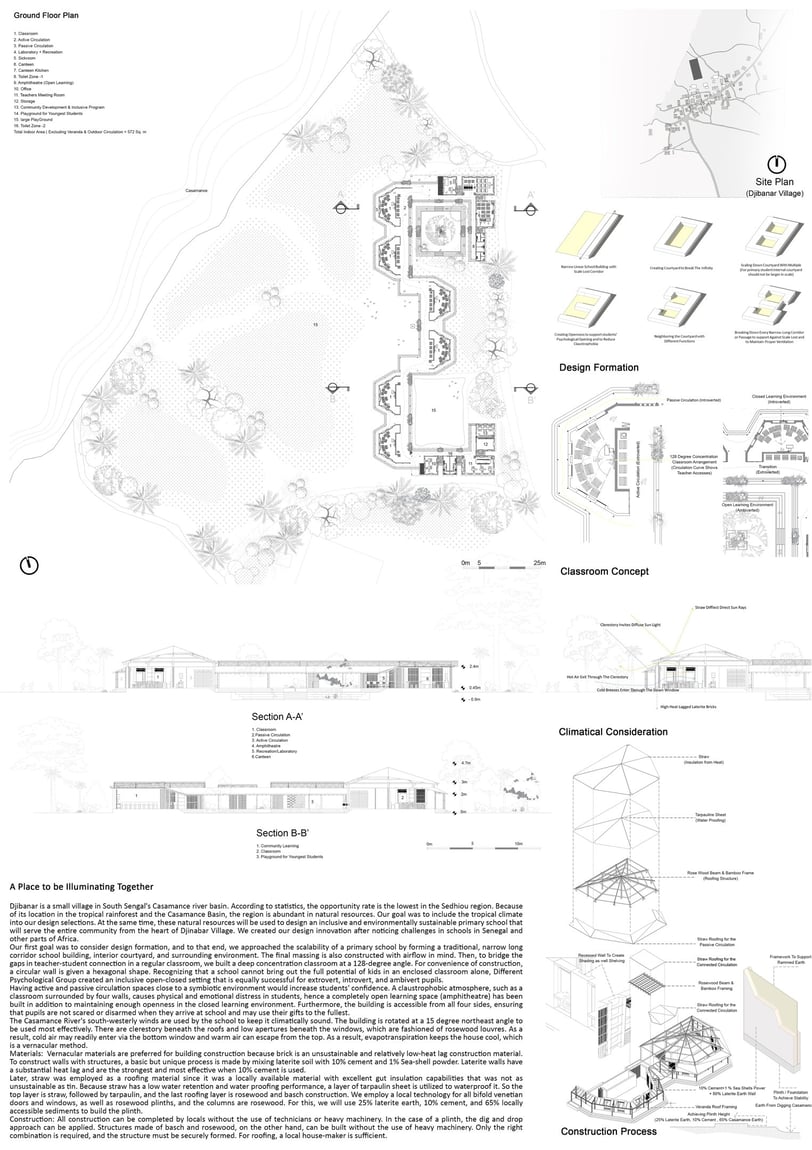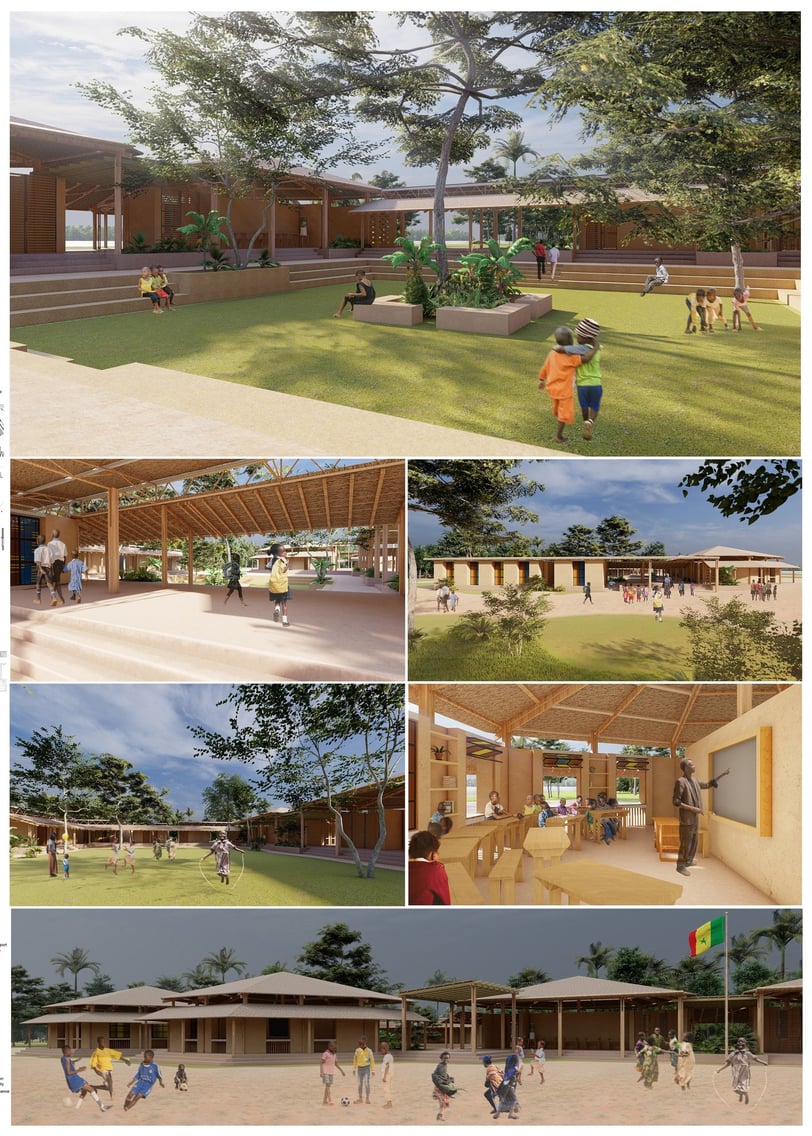Implementing Strategies of Vernacular Inclusive Schools in Rural African Tropics
Children living in the African tropics are the most deprived of access to proper education. This blog shows how to establish inclusive schools using vernacular elements in the African tropics.
COMMUNITYARCHITECTURAL STUDYEDUCATION
Muhammad Golam Sami , Mahmuda Yasmin Dola
7/31/20235 min read


Image: Primary School Design at Seidhou, Senegal by Muhammad Golam Sami & Mahmuda Yasmin Dola
A Place to be Illuminating Together
Djibanar is a small village in South Sengal's Casamance river basin. According to statistics, the opportunity rate is the lowest in the Sedhiou region. Because of its location in the tropical rainforest and the Casamance Basin, the region is abundant in natural resources. Our goal was to include the tropical climate in our design selections. At the same time, these natural resources will be used to design an inclusive and environmentally sustainable primary school that will serve the entire community from the heart of Djinabar Village. We created our design innovation after noticing challenges in schools in Senegal and other parts of Africa.
Our first goal was to consider design formation, and to that end, we approached the scalability of a primary school by forming a traditional, narrow long corridor school building, interior courtyard, and surrounding environment. The final massing is also constructed with airflow in mind. Then, to bridge the gaps in teacher-student connection in a regular classroom, we built a deep concentration classroom at a 128-degree angle. For convenience of construction, a circular wall is given a hexagonal shape. Recognizing that a school cannot bring out the full potential of kids in an enclosed classroom alone, Different Psychological Group created an inclusive open-closed setting that is equally successful for extrovert, introvert, and ambivert pupils.
Having active and passive circulation spaces close to a symbiotic environment would increase students’ confidence. A claustrophobic atmosphere, such as a classroom surrounded by four walls, causes physical and emotional distress in students, hence a completely open learning space (amphitheatre) has been built in addition to maintaining enough openness in the closed learning environment. Furthermore, the building is accessible from all four sides, ensuring that pupils are not scared or disarmed when they arrive at school and may use their gifts to the fullest.
The Casamance River's south-westerly winds are used by the school to keep it climatically sound. The building is rotated at a 15-degree northeast angle to be used most effectively. There are clerestory beneath the roofs and low apertures beneath the windows, which are fashioned of rosewood louvers. As a result, cold air may readily enter via the bottom window and warm air can escape from the top. As a result, evapotranspiration keeps the house cool, which is a vernacular method.
Design Concept
Due to the high dropout rate of African students in rural regions, a lack of inclusivity in school is mainly responsible for this situation. Because of this, children do not feel safe and comfortable. Furthermore, the claustrophobic environment inhibits their social connection as well as their physical and mental potential growth. As a result, we have attempted to create an atmosphere in which children may benefit from both active and passive circulation. We have established the class and an approach to allow students to ultimately develop themselves in the school's dynamic educational environment beyond the class's boundaries.
Regarding the seating arrangement of the class, we have come out from the traditional row-column layout and intended to create a class that would allow the teacher to focus, care for, and teach equally to all students. The following is not simply a student-to-teacher atmosphere but also a teacher-to-student environment.
Again, we did not construct the classroom as a single space but established multilevel spatial arrangements for the classrooms to become students' homes. For example, an introverted student sitting alone on the balcony during Tiffin can enjoy his or her individuality introvertedly, including passive circulation. Similarly, for extroverts, every classroom offers an active semi-outdoor space. The integration of active and passive space will result in a dynamic spatial character that will contribute to the positive psychological development of all children who are introverts, extroverts, or ambiverts, as well as the establishment of inclusion.
At the same time, our team has designed a physically challenged, student-friendly environment. We have met the best wheelchair circulation standards in the corridor, balcony, and doors. In addition, a physically challenged toilet zone has been constructed. Ramps have also been used to allow physically challenged students access to the platform.
The canteen and sickroom have been created to provide students with food and health care. For hungry children, there is also a kitchenette in the canteen. Furthermore, clean drinking water has been made available in each zone. The bathroom facilities have been created to be used as changing rooms.
It is crucial for a school to have a space that supports cross-curriculum for students' socio-psychological development. With this in mind, we designed a courtyard-style sunken amphi that will develop many qualities in students, such as communication quality, communal bonding, perseverance, and peacefulness. Furthermore, the place of study will help in the development of relationships and co-curricular activities among students from various classes. For the youngest children in primary school, courtyard-like playgrounds have been designed, which are separate from the main field and supervised by teachers and guardians.
A distinct community learning environment has been established to assist the old illiterate people of Djibanar and serve as a communal learning area where the inclusivity of this primary school will be maximized.
The long corridor area has been converted into a semi-outdoor space and given a multiphase breakdown in such a way that visual connection is maintained while eliminating the lost psychology of the scale of narrow and linear length in the spatial context, allowing students to mentally connect with the space.
Above all, the main objective of this project is to foster confidence in students and to empower them through a unique educational system arrangement, community approach, openness, multiphase level educational experience, and inclusiveness.
Use of Materials
Vernacular materials are preferred for building construction because brick is an unsustainable and relatively low-heat lag construction material. A basic but unique process is made by mixing laterite soil with 10% cement and 1% Sea-shell powder to construct walls with structures. Laterite walls have a substantial heat lag and are the strongest and most effective when 10% cement is used.
Later, straw was employed as a roofing material since it was a locally available material with excellent gut insulation capabilities that was not as unsustainable as tin. Because straw has low water retention and waterproofing performance, a tarpaulin sheet is used to waterproof it. So, the top layer is straw, followed by tarpaulin, and the last roofing layer is rosewood and basch construction. We employ a local technology for all bifold Venetian doors, windows, and rosewood plinths; the columns are rosewood. We will use 25% laterite earth, 10% cement, and 65% locally accessible sediments to build the plinth.
Construction Process
All construction can be completed by locals without the use of technicians or heavy machinery. In the case of a plinth, the dig-and-drop approach can be applied. Structures made of basch and rosewood, on the other hand, can be built without the use of heavy machinery. Only the right combination is required, and the structure must be securely formed. For roofing, a local house-maker is sufficient.




Meet The AuthorS


Muhammad Golam Sami
B. Arch, Khulna University of Engineering & Technology, Khulna, Bangladesh Architect | Futurist | Sustainable Design Expert
Operational Head, ADORA Studios, Bangladesh
Founder, samism.org
Lecturer, Department of Architecture
Northern University of Business & Technology


Mahmuda Yasmin Dola
B. Arch, Khulna University of Engineering & Technology, Khulna, Bangladesh Architect | Analytical Practitioner
Head of Construction, ADORA Studios, Bangladesh
CMO & Head of Construction, SS Construction & Power Solution, Bangladesh
Related ARTICLES
Related PROJECTS
An Elementary School: Designing a Path Towards Exploration
The main objective of this project was to design an elementary school for children, creating a child-friendly environment as well as designing a continuous exploration path that supports children's psychology and resists getting lost.
Image: Elementary School Project - Playground
Location: Mujgunni, Khulna; Year: 2018




